LOST IN TRANSLATION
The UFO Phenomenon as an Informational Virus
by Iona Miller, Certified Hypnotherapist
(American Council of Hypnotist Examiners, #HT 187-206)
©March, 1995
Updated 3/2000
A report on the nature of consciousness, perception, memory, dreams, hypnosis,
process-oriented therapy, paranoia, false memory syndrome, neuropsychology,
geological anomalies, and the UFO-ET phenomenon. Despite the true
essence of any alien manifestation, this notion functions as an informational
virus which is a psychosocial reality. This mini-course in the complexity
of interrelated issues impacting the nature of perception is meant to help
sort out those phenomena, while deepening understanding of ourselves and
our relationship to the universe.

TABLE
OF CONTENTS

FOREWORD
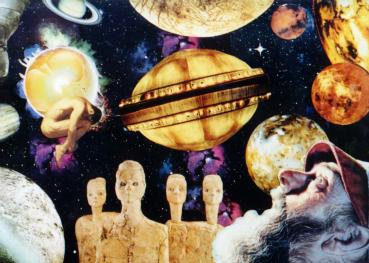
This is the report no one wants to read. For those skeptical of the
UFO phenomenon, it is far too permissive of the possibility of a different
reality than that dictated by the official reality of scientific reductionism.
For the True Believers, it won't go far enough to serve anyone's confirmatory
search.
While admitting the possibility that some people may experience UFO-ET
contact, this report speculates that it is a contagious notion which has
invaded the collective imagination, and many individual psyches.
Therefore, it is useful in evaluating the whole scenario to take a look
at both sides of the argument.
1). UFO-ET phenomenon emerge from fauly cognitive processing, folklore
and pseudoscience, or
2). "They're here."
As of this writing (4-95), Disney has begun the promotion of a new experiential
novelty, which will blur the distinction between fantasy and reality even
further. "Tomorrowland" is set to offer a virtual reality experience
of alien abduction open to all comers. It seems as if this "psychic
implant" might have emotional repurcussions which are as yet unknown, and
color or condition future "contactee" reports.
As if we have not been permeated enough with visual and auditory images
of this experience, we can now partake of it recreationally, in the theoretically
"safe," multisensory, full-immersion environment. As entire generations
partake of this imaginative experience and it becomes embedded in their
consciousness, it can condition any subsequent dreams and experiences,
real or imagined.
Disney's presentation is based on the premise that "they are here," and
the government is suppressing this fact from public knowledge. We
can only speculate on why one of the most powerful forces in Hollywood
would make a choice to take such a political stand in regard to this phenomenon.
The paranoid might ask "What if it is some kind of sick desensitization
project? And what about that short, humanoid "mouse" with the big
cranium and slight body?" Are you ready for "Hybrid Mickey?"
MEMES
[2000 update]. Since this book was originally written there has been
an increase in interest and literature about the notion of social contagions,
as originally described by psychologist Carl Jung. The books out
now include Thought Contagion: How Belief Spreads Through Society,
by Aaron Lynch, The Meme Machine by Susan J. Blackmore, The Selfish
Gene by Richard Dawkins, and
Virus of the Mind: The New Science
of the Meme, Richard Brodie. These books don't specifically
analyze UFO phenomena, but some of these authors, such as Blackmore, have
discussed it elsewhere. So have the scientists who support CSICOP
and its organ The Skeptical Inquirer.
This literature attempts to show a predictable expansion-contraction pattern
to the social spread of ideas. A meme is a self-propagating idea,
a unit of cultural imitation that, much like a biological or computer virus,
effectively programs its own retransmission. They spread through
motivating their "host population," novel configurations of old ideas,
and by proselytizers. Popular beliefs spread like contagions--cognitive
viruses.
But where do the original notions originate? Does it come from our
cultural paranoia about invasions ingrained from the cold war? Does
it come from a quasi-religious yearning for contact with something greater
than ourselves? Neurologist Michael Persinger has put forth a "Temporal
Lobe seizure" theory based on his electromagnetic experiments with subjects
at Laurentian University in Toronto, Canada. See his hard-to-find,
expensive, but excellent book, The Neuropsychological Bases of God Beliefs.
He also has investigated the relationship between UFO sightings and fluctuations
in the local conditions of the earth's magnetic fields and their relationship
to luminous bodies generated by tectonic forces, called Earth Lights or
free-floating plasmas.

INTRODUCTION
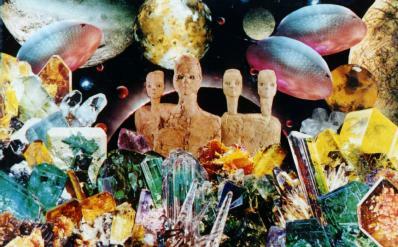
The hallmark of postmodern philosophy has been disbelief or skepticism
of all "metanarratives," or translations of reality. Postmodernism
has even turned its profound skepticism on such important humanist concepts
as "objective truth" and reason.
Yet, for a deconstructionist postmodern society, individually we are still
riddled with superstition and gullibility, and open to manipulation through
our belief systems as any politician, philosopher, clergy, or salesperson
will attest.
Further, most people are painfully naive when it comes to even the simplest
scientific understanding. Most of us don't have a clue about the
fundamental nature of physical reality or our own psychological nature,
and our ability to be fooled by our senses and mind.
Physical and psychological aspects of consciousness are studied in the
interdisciplinary cognitive sciences, which include philosophy, psychology,
linguistics, anthropology, neuroscience, and artificial intelligence.
The new science of consciousness is emerging from an interface with the
new postquantum physics.
A maverick tack in mind science research is the quest for sentience in
other dimensions, meaning we have begun using our own minds in a multidimensional
way. Perhaps psychology is more complicated than physics because
inner space has more dimensions than outer space.
A major accomplishment of cognitive science has been the clear demonstration
of the validity of positing a level of mental representation; a set of
constructs can be invoked or the explanation of cognitive phenomena, ranging
from visual perception to story comprehension. These representational
assumptions and concepts are now taken for granted and permeate the cognitive
sciences.
Many vocabularies and conceptual frameworks have been used to characterize
the representational level, including scripts, schemas, symbols, frames,
images, mental models, etc. Terms used to describe the operations
carried our upon these mental entities include transformations, conjunctions,
deletions, reversals, and so on. There may be several varieties of
representations, perhaps on a continuum from implicit to explicit, or from
hard-wired to flexibly programmed.
Nature rejects the naivete that seeks absolute truth. We are beginning
to realize, individually and culturally, that "realities" are all human
constructions. The task becomes one of "catching ourselves in the
act" of creating our own "reality" from the flow of events. Human
truth is always an engagement of mind with experience.
The challenge of the therapist in these times of chaotic change is to validate
the concept that we don't have to fear the collapse of what we think we
are. We can embrace this dissruptive chaos, trusting that it is an
emergent self-organizing process. We don't need to fear the collapse
of our personalistic belief system (the "box" we live in), nor our belief
in absolute truth.
Metaphor--what an experience is like--is the structure producing coherent,
ordered experiences. "How we know what we know" is encoded within
our own unique epistemological metaphors, which describe what our personal
experience is like. Narration, or storeytelling puts the general
human condition into the particulars of experience. The metaphors
are usually those of physical experience.
We construct a reality based on our belief system about what is "out there"
and "in here" and live within that framework, unless something or someone
unpredictably disrupts that image.
Though we share some firmly held notions about reality, there is no Archimedian
point from which we can compare our views of the world to the world itself.
We cannopt step out of our culturally limited perspective to see how things
really are in themselves.
A strong desire to engage in the "quest for uncertainty" complements our
anxiety that perhaps there is no absolute, objective ground to reality.
The warrant of Truth is ever-elusive when we deconstruct the foundational
justifications of our convenient notions about the way the world works.
It is easy to confuse what is actually the creation of beliefs with the
"discovery of Truth," a common goal of science and theology.
The scientific model of reason and universal rationality is evolving toward
fuzzy logic, a new model of perception of reality. "Fuzzy philosophy"
is a relativistic perspective of conceptual modeling.
Fuzzy philosophy is based on acceptance of degrees of truth, the "grayness"
(truth values) of most propositions. Paradox and polarization are
the results of a consciousness conditioned to think in terms of opposites,
black and white thinking.
Rather than approaching UFO-ET phenomena as real-unreal, or true-untrue,
we can reframe these experiences in terms of the meaning of the transformational
relationships. In this analogy, the prevalance of "the Grays" seems
to point in the direction of this new paradigm. Surety and fact meld
into psychic reality.
To "fuzzy consciousness" nothing is absolute. It frees us from having
to choose one polarity over another. It helps us accomodate conflicting
concepts, keeping us open to examining the "evidence" from both sides.
Thus, we can "believe" to a limited degree without unconditional surrender
of our critical faculties, and still continue to question skeptically,
and evaluate each event on its own merits.
As we will see in this report with its critique of both sides of the argument,
the facts usually are partially true or false. Even the best scientific
experiment only proves or disproves a particular notion. No study
can explain away all of the particulars of the UFO-ET scenario, though
debunkers try to dismiss them in toto.
To the extent science has measured facts and interpreted them in all or
nothing terms, it has failed to describe experiential reality. "Truth"
doesn't always match the facts.
Logic and chaos, like any pair of opposites, meet and merge at the boundary.
This boundary domain is the creative "edge of chaos," "the twilight zone,"
"the crack between the worlds," where the two meet and progressively meld
into one another.
The surety of fact melds into psychic reality. In this mode, there
is a suspension of the tension between the opposites of the logical and
natural mind. Beyond the paradox of yoked opposites lies the realm
of relative "truth."
The "Fuzzy Principle" is described and experienced as vagueness, "shades
of gray." There are an infinite number of gray values on the continuum,
which spin out an infinite number of fractal solutions.
Fuzzy thinking can help us revision our perspective on the relationship
of mankind and the Other -- the interrelationships of man and transpersonal
forces, including God and nature, life and death, and extraterrestrial
entities. It is part of our adaptive evolution, provoking a quantum
leap in our consciusness by challenging us with chaotic perturbations at
the foundational level.
In terms of the UFO-ET phenomenon, fuzzy logic defines tthe degree of containment
within that discrete mode of reality, which presents us with universal
physical and sociological consequences. What any ultimate consequences
of this phenomenon might be are open to speculation.
Whitley Streiber, whose autobiographical novel and movie COMMUNION,
probably did the most to popularize the notion of alien encounter and abduction
has come to conclude that,
"This is not unconscious debris, but something above what we call consciousness.
The human mind seems to exist in some way on a hyperphysical and hyperdimensional
level, perhaps even a hypercognitive level."
"What is happening is that the barriers between this hypercognition
and normal cognition are falling, and we're finding that there is a physical
evolution of humankind that exists at this hyperphysical and hypercognitive
level."
"What I'm looking forward to, is seeing the nature of human experience
change as our consciousness rises toward this hyperconsciousness, and we
begin to understand this higher level of physical being...this is essentially
a vast, immensely subtle, immensely complicated theatrics of hyperconsciousness
trying to penetrate our level of reality. It is like someone knocking
at the door, something trying to get us to move up, to wake up and to come
up in scale."
Further he states, "When the authorities try to impose themselves on
the experience, all they do is narrow it to their belief system.
In other words, it gets filtered through what they expect. It can't
be like that. It's got to be between the individual and whatever
this is, so that it gets narrowed through everybody's experience, without
the need for anybody telling anyone what to do."
He echoes the sentiment of others when he speculates that over the next
one- or two-hundred years that "society is going to completely recast
itself as a reflection of hypercognititve thought. What that will
mean, I have no idea."

PART
I
ABSTRACT:
This paper is based on the hypothesis that whether UFO-ET phenomenon have
"objective" reality or not, the notion of their existence functions as
an informational virus. Despite the true essence of any alien phenomenon,
this contagion is a psychosocial reality.
Any self-styled UFO investigator should become aware of the nature of all
kinds of false interpretations of ambiguous experience in order to separate
out any alleged experiencers. This mini-course in the complexity
of interrelated issues impacting the nature of perception is meant to help
sort psychosocial phenomena from any potential alien manifestations.
Buzz-words like
Denial, False Memory Syndrome, Paranoia are easy to throw around without
understanding their subtle qualities; they are not included here as ways
to dismiss contact reports, but as ways of deepening our understanding
of various phenomena.
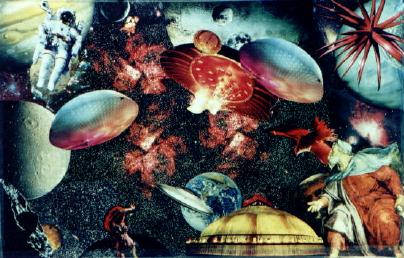
We live in the information age. Information is energy, and is furthermore
the most fundamental form of energy. And--it's alive! And it
wants to be free. Information in action -- dynamic information --
is a powerful force.
Permeating the living reality of our culture are certain contagious notions
which have the ability to influence the way we think about the nature of
ourselves and Reality. Jung described the concept of psychic contagion
by certain archetypal forces inherent in the human psyche, which manifest
in our spiritual lives and belief systems. He spoke of both conscious
and unconscious contamination.
Notions like this range from simple superstitions to scientific concepts,
to urban myths. Notions sweep through our culture and insinuate themselves
within its fabric, as fads, whether they are "real" or not, they can be
influential. An analysis of these notions is useful in distinguishing
a common human phenomenon from any potential "alien influence" which may
or may not be exerted on us from an unknown Source.
"Alien invasion" is a powerful root metaphor for penetration by forces
we perceive as originating outside of ourselves. A contagious notion
like this can contaminate our conscious and subconscious life, much like
a computer virus moves through an operating system creating wormholes in
the informational net, destroying the old order and leaving fragmentation
and disintegration in its wake. Like some weird parody of "The
Alien," this notion eats at us from the inside out.
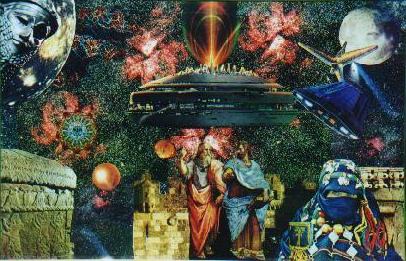
MILLENNIAL FEVER
There is a meta-myth operating in society as we approach the year 2000
and beyond. Cotemporaneous with "Alien Contact," this contagious
notion within our midst can be termed "Millennial Fever," and it is not
limited to apocalyptic Christian thought. Even athiests, scientists,
humanists, and neo-pagans get millennial fever. If one date doesn't
deliver the prophecy results, it gets postponed to another future event.
There are many variations on the themes of prophetic doom, and utopian
triumph -- salvific formulae for survival in the age of information anxiety
and radically advancing technology.
Many of these variations share the theme that humanity will be translated
to a higher order of Being, some sort of hyperdimensional Eden. What
if it is all true? The prospect is pretty overwhelming. How
many casualities of such a process could be "Lost in Translation"?
Is "the End" any nearer than the aliens, or (horrors!) do the two prophetic
streams relate to each other? Are we moving deeply into some process
of self-fulfilling prophecy?
Even the notion of totally public Alien Contact reflects this sense of
a Strange Attractor in human history or Time itself, just beyond the horizon
of our immediate Future. But some report that contact Now, rather
than in some ever-elusive future time.
ALIEN STOCK IS UP
Globally, there is an upwelling wave of cultural interest in the UFO-ET
phenomenon. It is reflected in an increasing number of reports and
investigations, as well as its ramifications in psychotherapy, and simple
market trends.
Ufology is riding the crest of a wave which has made it one of the most
marketable subjects, as witnessed by the many television and talk radio
shows dedicated to it. At the 1995 Seattle Whole Life Expo, fully
one-fourth of the headlining "experts" were directly speaking on this subject,
whle an additional one-eighth of the total speakers addressed the subject
and its tangents. The topic is second only to sex on the internet.
Major book publishers and distributors have a renewed interest in securing
their market share, not to mention the plethora of videos being produced
and marketed by wholesalers, such a "UFO CENTRAL." The ubiquitous
presence of the family camcorder has led to the dissemination of far more
credible evidence than has ever been available, and resources to concoct
hoaxes, as well.
For many, seeing is believing. One in ten say they've seen a UFO.
According to a survey by one national newspaper, fully 91% of us believe
Earth has been visited by extraterrestrials. This belief alone indicates
a psychosocial phenomenon of huge magnitude, even without addressing the
broader "reality" of UFO-ET scenarios.
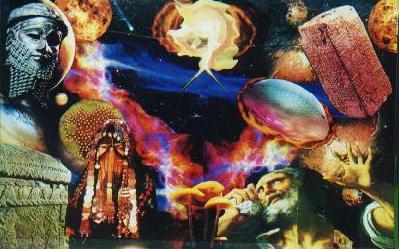
THE NATURE OF PERCEPTION
This phenomenon begs us to examine every related issue, such as the nature
of consciousness, perception, beliefs, memory, dreams, memory of dreams,
the formation of imagery and its philosophical counterpart -- our worldview.
Our beliefs underlie what we do, feel, and think, and condition what we
allow ourselves to experience. The mind tends to fill in the blanks:
"I wouldn't have seen it if I hadn't believed it."
Skeptics assert that our minds take in information from the environment,
combine it with aspects of memory, shape it to satisfy certain needs, and
produce a belief that may or may not have anything to do with reality.
Adding to that a tendency toward "magical thinking" left over from childhood,
and we must be to some degree suspicious of our own experience, never mistaking
it for Truth.
The phenomenal world is a world of repeated wonders, which though experienced
by people in every generation, elude reasonable explanation, yet survive
every attempt to exorcise or suppress them. Such phenomena are repetitive
and affect people mentally or physically. They include the real phenomena
of the everyday world. On their own level they correspond to the
archetypal themes of mythology and the archetypal images in dreams.
The phenomenal view is based on life as experienced rather than as conceived.
The phenomenological viewpoint accepts everything, believes absolutely
nothing, and does not explain anything. Theories are introduced only
tentatively and temporarily, while the focus remains on the content of
human experience: things that happen or are believed to happen, or are
said to happen. Products of nature or imagination, first-hand witnessing
is a different order of experience than second-hand rationalization.
Phenomenologists recognize no certainties, and don't care for explanations.
For example, the tendency of the UFO cult to identify the great sanctuaries
of prehistoric civilizations as the work of extraterrestrial spacemen.
The hope of neo-phenomenalism is to look at the universe directly with
nothing to prove--no faiths, theories, or taboos to inhibit the process.
Humans in general believe in the ideas we comprehend as quickly and automatically
as we believe in the objects we see. Comprehending and accepting
are functionally the same--a notion's symbolic representation is treated
as if it is true.
In dreams unconscious ideas that were kept in the psyche in mute and invisible
ways become transformed into representational forms. According to
Winson (1990), dreams also are the means by which we "form strategies
for survival and evaluate current experience in light of those strategies."
Both he and researcher J. Allan Hobson agree that dreams directly reveal
our view of the world and deep aspects of ourselves. This reiterates
the same discoveries in depth psychology by Freud and Jung.
Perception inclues a complex set of phenomena that intervene between sensory
stimulation and conscious awareness. Jung studied this threshold
and found the panoply of symbolism of the collective unconscious.
According to Freeman (1991), "the brain moves beyond the mere extraction
of features--how it combines sensory messages with past experience and
with EXPECTATION to identify both the stimulus and its particular meaning
to the individ ual." The result is a meaning-laden perception--a
gestalt--that is unique to each individual.
Modulatory chemicals, such as noradrenaline and endorphins, released into
the brain increase sensitivity to input, both by participating in the formation
of connections and by enhancing arousal. This sensitivity allows
a very small signal--a whiff, a whisper, a glimpse--to trigger a massive
collective state change, the "butterfly effect" of chaos theory.
In the general dynamics of perception, the brain seeks information by directing
us to look, listen, and sniff. "The search results from self-organizing
activity in the limbic system (involved in emotion and memory), which funnels
a search command to the motor systems. As the motorcommand is transmitted,
the limbic system issues what is called a reafference message, altering
all the sensory systems to prepare to respond to new information"
Freeman continues: "And respond they do, with every neuron in
a given region participating in a collective activity--a burst. Synchronous
activity in each system is then transmitted back to the limbic system,
where it combines with a similarly generated output from other sensory
systems to form a gestalt. Then, within a fraction of a second, another
search for information is demanded and the sensory systems are prepared
again by reafference."
"Consciousness may well be the subjective experience of this recursive
process of motor command, reafference and perception."
So the brain plans and prepares for each subsequent action on the basis
of past action, sensory input and perceptual synthesis. Consciousness
is bidirectional, both reaching out to the world and folding reflexively
in upon its own operations. Viewing consciousness as an emergent,
self-organizing phenomenon complicates the simple cause-effect (or stimulus/response)
model of cognition.
Consciousness is turbid when meanings are undergoing reconstruction in
an undetermined direction, and becomes clear as a decisive meaning emerges.
The convergence of all forms of sensory input provides a basis for the
unity of consciousness. The act of perception is a creative act in
which the brain grows, reorganizes, reacts to and changes the environment.
Perception creates an "observation," arresting the flux of a world in continuous,
perhaps infinite, movement. Freeman concludes by noting that the
poet Blake wrote "If the doors of perception were cleansed, everything
would appear to man as it is, infinite." "Such cleansing," says
Freeman: "would not be desirable. Without the protection
of the doors of perception--that is, without the self-controlled chaotic
activity of the cortex, from which perceptions spring--people and animals
wold be overwhelmed by infinity."
When we make an observation, we "interfere" with the development or building
up of probabilities which "collapse" into one actual event. From
a quantum-physics perspective, the world is not solid, real, independent
from us, but exists in a limbo between real and possible. In a constructivist
view of the world, our paradigms determine how we organize it, but we can
determine our paradigms.
Perception itself is a mysterious phenomenon which transforms a physical
event (the stimulus) into a subjective experience. It permits a conversion
from matter to psyche, and the psyche mirrors the matter. Imagery
reflects the same process without a physical stimulus--the image mirrors
another mirror (perception). But the image is not a faithful mirror,
it is a creative mirror.
Even presuming the reality of extraterrestrial contact, any experience
is subject to contamination, or overlay, by the primal archetypal forces
inherent in mankind's psyche. Jung noted how such inner figures condition
our waking and dreaming experience, including among them the Shadow, Anima
and Animus, the Double, Trickster, Shaman, Magical Child, Hero, Senex,
and the Self (archetype of individuation).
All these forces can produce multisensory bizarre imagery. Any of
these variables could function as filters of a legitimate contact experience,
which would be virtually indistinguishable from a mirroring of the self.
Even external reality can mirror psychic reality through synchronicity.
Whitley Strieber described such an encounter in "The Aliens That Aren't."
In a multiple witness sighting, an entity transformed into completely different
states.
"...when the lady touched the so-called visitor, she thought it was
an animal who had come into the room. Of course, it couldn't have
been, because there was no way for an animal to get in. It then went
into another room, where it was seen by another individual. It went
down the hall and proceeded to wake up two people who were sleeping on
a couch. The man sleeping there saw it transform into something with
the head of an eagle, which has got all kinds of deep mythological signficance
for the human species. Then it just disappeared from the face of
the earth."
Most of us don't have a clue what's going on in our own transformational
dynamics because they fall into our psychological blind spots (lacunae).
Yet these archetypal images have the power to reshape our lives.
Their commonality with ET phenomena is that these complexes of experience
have the ability to somehow speak to our souls. When they confront
us, they dictate the terms of engagement.
They don't fit neat forms, because living images spill out of categories.
Their challenge draws us more deeply into the complexities of life and
the deep nature of our reality. Life-changing experiences change
us at the core level affecting our beliefs, attitudes, and behaviors.
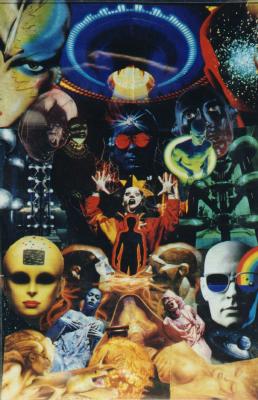
AN INFECTIOUS IDEA
The notion of human-ET contact is seemingly as infectious as it is mysterious.
More virulent than an airborne virus, it can even penetrate us subconsciusly
through the growing egregor in the collective unconscious of mankind--a
phenomenon similar to that of the "hundredth monkey syndrome," in
which parallel ideas occur in many minds virtually simultaneously.
The transmission can occur essentially telepathically, without any particular
intent of any person or group to disseminate the notion and embed it in
the belief system level of the masses. This, of course, does not
even call into question the possibility of governmental or ET mind control
tactics designed to selectively reveal and conceal alien presence among
us.
"Infection" can be gauged by the degree or intensity of involvement with
the phenomenon. Needless to say, most of these evaluations are subjective
since they are the result of self-reporting. The baseline of the
population obviously range from zero interest or involvement, to those
who are casually interested from random informational input, to those who
seek out information (voluntarily or compulsively) or contact or are sought
out by the phenomenon itself. In their confirmatory search, many
people without direct contact are drawn to those who did appear to experience
it, and seek them out as investigators or simply by attending UFO groups.
Personal experience is not a criterion for becoming a "True Believer."
Actual experience of UFO-ET phenomena is not necessary for interpreting
one's ambiguous experiences as "contact." Or, for others to interpret
it as such. The experiences of some respondents for one UFO psychosocial
study (Spanos, 1993) were "simply night dreams that involved UFOs and
aliens," yet they respond to an ad seeking "adults who have seen
UFOs," and were included in the experiencer subject group based solely
on these dream reports.
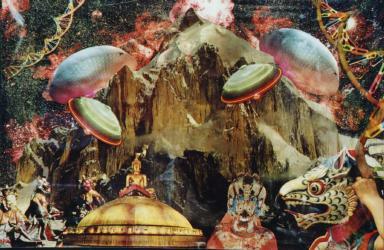
NO EXIT
There is little doubt that virtually everyone alive now is immersed in
an informational ocean permeated by the notion of possible alien contact
through a variety of sources ranging from science fiction to scientific
exploration, to the spiritual realization that we cannot possibly be alone
in the cosmic sense.
The degree to which we embrace that notion reflects more about ourselves,
rather than saying anything specific about the essential nature of this
informational virus. Permeating society and our individual psyches,
it sinks its tentacles into every functional aspect of life--physical,
emotional, mental, and spiritual.
The ambiguity of the phenomenon has led to a great deal of confusion in
the self-reports of individual experiencers, yet among the classic subtypes,
the reports are remarkably consistent in content and context. Like
visionaries, mystics, or initiates of the mysteries, subjects struggle
to find words adequate to describe ineffable experiences which have little
comparison to ordinary life.
Even the most impassioned narrative fails to convey the full emotional
impact of an intense encounter. Thus, these experiencers go through
an extreme loss of orientation--not only may they have been "lost in space,"
they are now "LOST IN TRANSLATION," alienated from their own experience
and consensus reality by a frustratingly inadequate narrative.
Psychotherapeutic protocols for dealing with this population are still
in the formative stages. For practitioners, there is a "damned if
you do or damned if you don't" aspect to the treatment of this syndrome.
It bears strongly on the issues of iatrogenic false memory syndrome, pseudomemories
which can be induced in hypnosis through rapport, and other processing
techniques which encourage metaphors to describe what experience is like.
Regarding the client, the practitioner is faced with the question "To Believe,
or not To Believe." Here again, contagion (and countertransference)
can change this perception at any point, through varying degrees of grayness
(no pun on "the grays" intended). Those who begin as disinterested
skeptics are often led toward an open-minded if not believing stance by
a preponderance of the evidence, both from investigation and the powerful
testimony of those with whom they deal.
Yet, research on issues such as sexual molestation and certain manifestations
of PTSD (Post Traumatic Stress Disorder) has shown that it is not absolutely
necessary to uncritically believe the unsubstantiated reports of clients
in therapy in order to help heal them. In many instances, the therapist
does not, and will never know for sure if the events occured as remembered
and reported, with or without hypnotic refreshing.
The most obvious example of this pioneering research is Harvard psychiatrist
Dr. John Mack, who has had the intellectual courage to treat abductees
"as if" their experiences are real. For a few years he has bucked
the academic system to forge his own path in this wilderness of the psychological
hinterlands.
But now, as of March 1995, he is being called to account academically and
ethically by his peers. Harvard is legally challenging his position
and assertions he has made in public as being professionally irresponsible,
and his tenured job is in jeopardy. Will his fate follow that of
another maverick Harvard psychologist who refused to be controlled by the
system and questioned the nature of reality and authority--Dr. Timothy
Leary?
Dr. Mack has chosen to validate the experience of his patients, whom he
has thoroughly tested and found to be of sound mind. This has both
relieved and disturbed many people who by proxy use his professional opinion
to evaluate themselves and their experience as having a greater degree
of reality. People want to believe in themselves and what their experience
seems to be telling them. But, as Dr. Mack notes, at bottom, "No
one really wants this to be True."
A potential problem, though, is that many people, also of sound mind, may
embrace this information to evaluate their own less intense experiences
as having an objective reality.
It is possible to be completely "normal" by every psychological criteria
and yet embrace one or more false beliefs which can function as a distorting
framework for viewing reality and oneself. These may or may not be
"Real," but functionally they may as well be. Thus, we have situations
such as Wacko, and Jim Jones, Heaven's Gate, etc. And there may be
no ultimate way to determine whether some constructs are or not objectively
real. Most of us would rather seek answers, than float aimlessly
forever in an ocean of ambiguity.
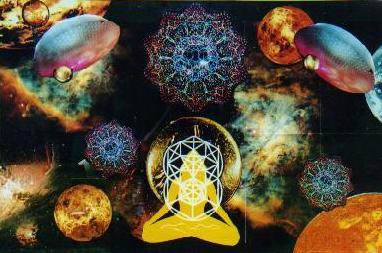
PENETRATING DREAMTIME
Perhaps this conundrum arises in the group experiencing UFO-ET dreams,
but with little or no other intense contact. Intensity can also escalate
in this dimension through changes in context and increased frequency of
Ufo related dreams. In light of the research, how are they to interpret
their dreamlife? If researchers accept this population as valid for
research's sake, how are they to view themselves?
These dreams are listed as one of the prominent "symptoms" of UFO abductees--but
the rabid rush to misdiagnosis among potential sexual molest victims based
on false memories and the "Satanic Panic" has led therapists toward caution
in applying "symptom lists" as criteria for diagnosis. In other words,
all UFO dreamers have had an imagery experience of some sort, but not all
UFO dreamers are necessarily abductees.
Even assuming an actual abduction pheonomenon, there will be those who
present for treatment with a potentially false belief that these dreams
make it so, or hide a deeper, repressed experience. This is the result
of psychic contagion--the reinterpretation retroactively or progressively
of the pure nature of one's experience according to an evolving worldview
of "the way things are."
In other words, the client, as well as an inexperienced practitioner can
have a hidden agenda based on conscious or subconscious beliefs about the
phenomena. For example, a latent grandiosity might lead to the desire
to expand on dream imagery and adopt and foster the notion that one is
"chosen" or "special" or singled-out, or conversely even low-grade paranoia
may lead to the notion of persecution, torment, or conspiracy.
Unfortunately, people always seem to be able to find just enough basis
in "fact" to corroborate any tendencies in these directions. The
psychological dynamic of projection moves the source of grandiosity or
paranoia from the inside to the outside. Paranoia and grandiosity
can even be contaminated with one another leading to an internal split--a
schizoid attitude, where one vacillates, either feeling subhuman or superhuman.
The reality of the phenomenon of psychic contagion does not negate the
possibility of the "Reality" of UFO-ET phenomenon. Even if "It" is
happening, there will be just as many individuals who will follow this
imaginal trend, like lemmings. It's the old "me, too" syndrome of
jumping on the bandwagon, swept away by the power of an idea, much like
we see cultish political or spiritual ideologies sweep through our cultures.
Something may be happening, but for sure this idea is in vogue. It
fascinates us, for whatever compensatory reasons it serves in our collective
psychic economy. If it is a "virus", we seem to somehow love this
dis-ease.
The UFO-alien mythology is archetypal. It has a certain bizarre charm--it
enchants and seduces us, drawing us deeper into its warp and woof--the
fabric that weaves its reality from our World Simulation Process.
This belief has the ability to take on a life of its own within us and
exert its influence on the nature and interpretation of our perceptions.
Charles Tart, the consciousness researcher who coined the terms of "Altered
States" or discret states of consciousness, reports (1990) on the nature
of the WSP: "The basic function of the World Simulation Process
is to create, maintain, expand and update internalized, rapidly functioning
internal models of the real world that will enable us to survive and function
efficiently in the real world."
"When the World Simulation Process gives us virtual realities that differ
from the real world in significant ways, we begin to behave maladaptively,
creating both real world consequences and/or psychological suffering in
ourselves and others. This statement is not as simple as it seems,
though, for deciding what is 'real' in the world is heavily influenced
by the virtual realities already created by our World Simulation Process."
None of us truly live in Reality--we reconstruct a synthetic reality, moment
by moment, based on our interpretation of our own sensory input, processes,
and our primal image of who we are. There is a spectrum of altered
states of consciousness we can experience, ranging from hypoarousal to
hyperarousal. Each of these color our perceptions. When those
processes are interpreted according to some filter, or overlay of what
reality is like, they are subject to possible undetected distortions.
Once again, this does not refute the testimony of self-declared abductees
and contactees. But it addresses processes within the bulk of the
population that may or may not relate directly to that phenomenon.
Ripples of reaction spread from the core-group of Ufologists and experiencers
into the population at large, manifesting as attitudinal shift, and pernicious
perceptual change -- reinterpretation of personal experience which begins
by implanting doubts about oneself and the origin and nature of ambiguous
experiences.
In his article on UFO dreams for DREAM NETWORK, McClanahan admits
that "UFOs and aliens began to appear in my own dreams during the fall
of 1989 when my focus-of-awareness became centered upon UFO research."
If many people are involved in contact phenomena, many more seem to WANT
to be involved in varying capacities. One often hears people remark
that they would love to see a UFO, make contact, or even voyage to the
stars. Failing this, they take up the hobby, seeking contact with
those who claim contact, whether in person or through taped reports, or
flock to Area 51.
Immersion in this informational ocean leads to a "download" of "validating"
data which sets the stage for the zealous "seeker." Seeking typically
leads to conversion, which leads to the quantum leap of True Believer.
Yet, those who report the most intense involvements frequently never "believed"
in the phenomenon, and confronted with the traumatic nature of their alleged
experience don't want it, don't want it to be real, want release from a
typically intergenerational cycle, and frankly wish it would all just go
away. Furthermore, abductees' social interaction with others is not
only conditioned by their experiencee, but by others fascination with or
derision for their story. The net result is traumatization, before,
during and after the "fact."
This story of helpless traumatization by "The Other" is as old as mankind.
Contact with the ineffable is a Mysterium Coniunctionis, the collision
of awesome and terrible forces both "good and evil." Joni Mitchell
penned her song "The Sire of Sorrow" as a lament of the ancient
patriarch Job -- but it is not hard to hear in this poem the collective
voice of abducteess trying to come to terms with their experience.
Job's cry is mankind's universal lament and question, "Why do we suffer?"
As Job wrestled with his sorrow, the "Angel" of the Lord, so we wrestle
with the alien "invasion," while some of the radical investigators
allege that "it is all over but the screaming!"
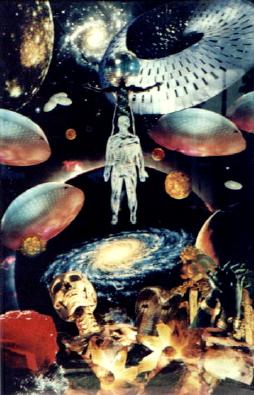

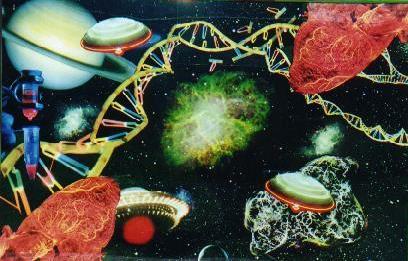

UNDER CONSTRUCTION
File Created: 3/1/2000 Last Updated: 6/19/2000
Web Design by Iona
Miller and Vickie Webb.




